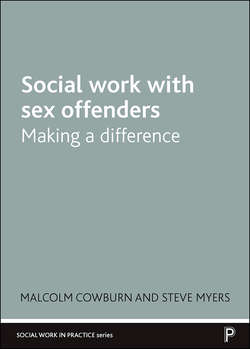Читать книгу Social Work with Sex Offenders - Cowburn Malcolm - Страница 28
На сайте Литреса книга снята с продажи.
Chapter 2 Understanding sex crimes and sex offenders Introduction
ОглавлениеThe aim of this chapter is to outline and explore the contribution of key academic disciplines to understanding sex crimes and sex offenders. Sociological, biomedical, theological, legal and psychological perspectives are considered. In identifying individual disciplines, we recognise that each discipline is heterogeneous, and that forms of knowledge may be contested within each discipline. Moreover, knowledge within each discipline may be developed from differing epistemological positions (eg an evolutionary psychology account of sex crime differs significantly from a feminist psychological account).
The chapter initially considers victim perspectives. Victims’ experiences are individual, and although a range of studies identify common impacts of violation, no systematised knowledge of sex crimes has been generated from such experiences. These accounts, however, make an important contribution to understanding sex crime and developing law and penal practices via victims’ organisations. This has been particularly important in articulating and asserting victims’ experiences of sex crime. We then move on to academic accounts of sex crimes. Sociological understandings of sex crime move beyond legal definitions (eg feminist accounts of sex crimes, which focus on patriarchy and the problem behaviours of the general population of men), but also analyse the behaviour of convicted populations (eg in studying what helps sex offenders desist from offending). The term ‘theological’ is used to recognise that, through history, various (theocentric) religions in different parts of the world have made statements about the nature of various sexual behaviours; proscribed behaviours are defined as sins. In secular societies, crimes are defined by law, which is often influenced by dominant theological frameworks and, according to one’s epistemological position, either represents the ‘moral consensus’ or the interests of dominant groups (eg think about the criminalising and decriminalising of ‘homosexual’ activity). Biomedical understanding of ‘sexual deviation’ is independent of the law, defining some sex offences as the result of (mental) illness. However, as with the law, the viewpoint generally embodies dominant moral values but uses ‘scientific’ language to define a variety of sexual predilections, including those that inflict harm on non-consenting victims. These definitions focus on the acts deemed to be wrong, illegal or deviant. Psychological perspectives tend not to define particular acts (other than to recognise that they may be illegal and harmful) within an overall schema; rather, the focus is on individuals manifesting problematic behaviours (as defined by themselves or the criminal justice system). Forensic psychology has developed a range of classificatory systems for people who have sexually harmed children and adults; these systems carry implicit or explicit aetiological assumptions about the behaviours.
Figure 2.1 illustrates the interrelated nature of these perspectives, with individualised concerns nearer the centre of the circle. Societal responses to sex crimes are embodied in penal policy and the practices of the criminal justice system; it is within (and beyond) these that social workers primarily operate.
Figure 2.1: Understandings of sex crimes
The third part of the chapter is concerned with exploring issues relating to sex offenders. We register three caveats. First, we recognise and discuss ‘unconvicted’ sex offenders in the second part of this chapter; in the third part of the chapter, the discussion focuses on convicted sex offenders. Second, the generic term ‘sex offender’ conceals the heterogeneity of the sex-offending population; in our statement of values in Chapter One, we recognise that sex offenders are a diverse population, and, where appropriate, we highlight and discuss issues of difference. The final caveat recognises that discussion of the ‘individual’ sex offender potentially ignores group offences (eg gang rapes, paedophile rings, ‘sex’ trafficking and rape in conflict and post-conflict settings). The making and viewing of child pornography is both an individual and a group offence (see Henshaw et al, 2015). Group offending dynamics are largely beyond the scope of this book and we refer readers to the following sources as starting points for further study: on gang rapes, see Chambers et al (2013); on females in gangs, see Wijkman et al (2015); on trafficking, see Breuil et al (2011); and on rape in conflict and post-conflict settings, see Sexual Violence Research Initiative (2014).
